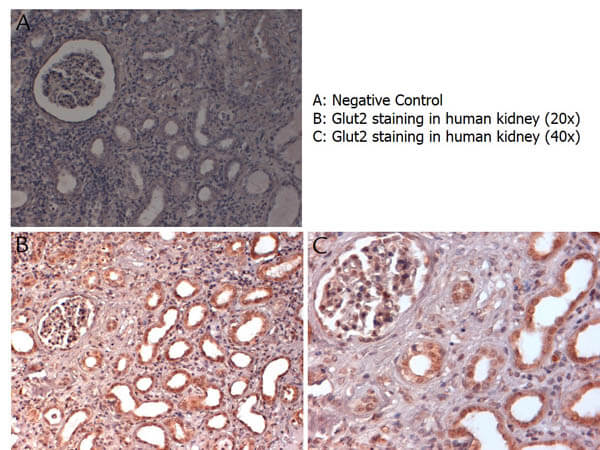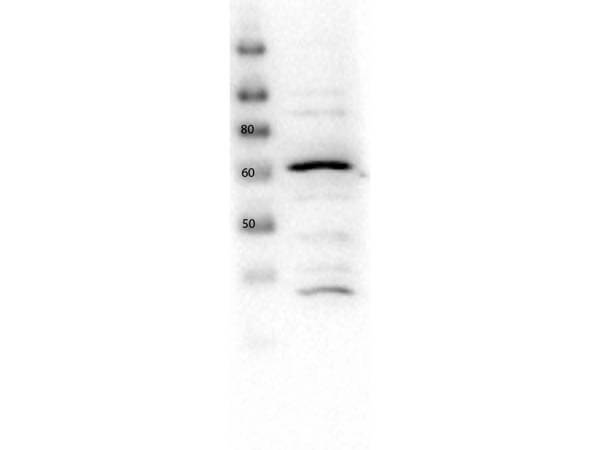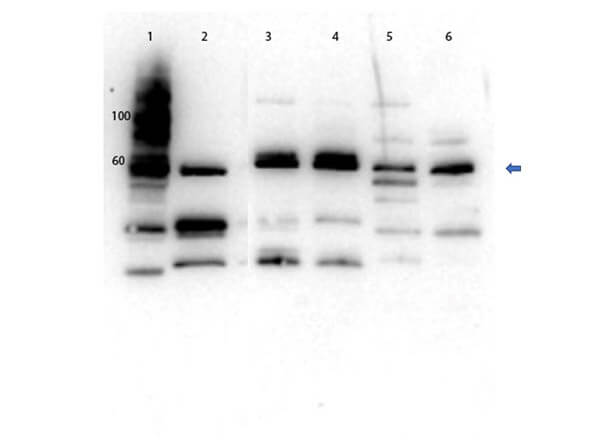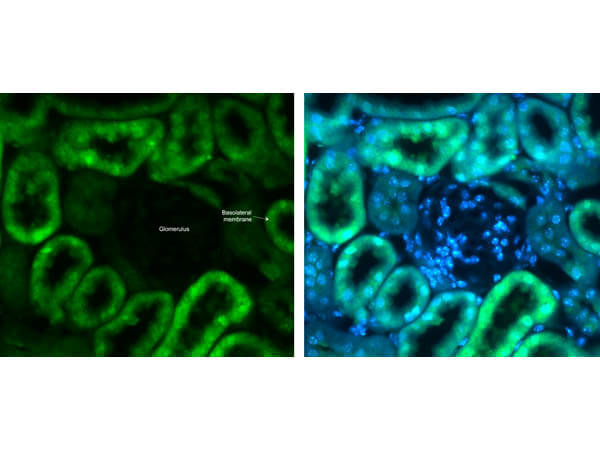Datasheet is currently unavailable. Try again or CONTACT US
Glut2 Antibody
Rabbit Polyclonal
7 References
600-401-GN3S
600-401-GN3
25 µL
100 µg
Liquid (sterile filtered)
Liquid (sterile filtered)
WB, ELISA, IHC, IF
Human, Mouse
Rabbit
Shipping info:
$50.00 to US & $70.00 to Canada for most products. Final costs are calculated at checkout.
Product Details
Anti-Glut2 (RABBIT) Antibody - 600-401-GN3
rabbit anti-Glut2 antibody, Solute carrier family 2 facilitated glucose transporter member 2, Glucose transporter type 2 liver, GLUT-2 antibody, Slc2a2, Glut 2 Antibody
Rabbit
Polyclonal
IgG
Target Details
Slc2a2 - View All Slc2a2 Products
Human, Mouse
Conjugated Peptide
This affinity-purified antibody was prepared from whole rabbit serum produced by repeated immunizations with a synthetic peptide corresponding to the C-terminal domain of mouse Glut2 protein.
This affinity-purified Glut-2 antibody is directed against Glut2 protein. The product was affinity purified from monospecific antiserum by immunoaffinity purification. A BLAST analysis was used to suggest cross-reactivity with Glut2 from mouse and rat based on a 100% homology with the immunizing sequence. Reactivity against homologues from other sources is not known.
Application Details
ELISA, IF, IHC, WB
Anti-Glut-2 antibody has been tested for use in ELISA, immunohistochemistry, immunofluorescence, and by western blot. Specific conditions for reactivity should be optimized by the end user. Expect a band approximately 57.1 kDa in size corresponding to Glut2 protein by western blotting in the appropriate stimulated tissue or cell lysate or extract.
Formulation
1.0 mg/mL by UV absorbance at 280 nm
0.02 M Potassium Phosphate, 0.15 M Sodium Chloride, pH 7.2
0.01% (w/v) Sodium Azide
None
Shipping & Handling
Dry Ice
Store vial at -20° C prior to opening. Aliquot contents and freeze at -20° C or below for extended storage. Avoid cycles of freezing and thawing. Centrifuge product if not completely clear after standing at room temperature. This product is stable for several weeks at 4° C as an undiluted liquid. Dilute only prior to immediate use.
Expiration date is one (1) year from date of receipt.
The Anti-Glut2 antibody was designed, produced, and validated as part of the Joy Cappel Young Investigator Award (JCYIA). The glucose transporter GLUT2 is a transmembrane carrier protein that allows protein facilitated glucose movement across cell membranes. GLUT2 is expressed in the plasma membranes of the liver, intestine, renal tubular cells, pancreatic islet beta cells, as well as in the portal and hypothalamic areas. Due to its low affinity and high capacity, GLUT2 transports dietary sugars, glucose, galactose and fructose in high concentrations, displaying large bidirectional fluxes in and out of cells. In pancreatic beta cells, GLUT2 is essential for glucose-stimulated insulin secretion. GLUT2 expression is necessary for the physiological control of glucose-sensitive genes, and its inactivation in the liver leads to impaired glucose-stimulated insulin secretion. In the nervous system, GLUT2-dependent glucose sensing regulates feeding, thermoregulation and pancreatic islet cell mass and function, as well as sympathetic and parasympathetic activities. In humans, inactivating mutations in GLUT2 cause Fanconi–Bickel syndrome, which is characterized by hepatomegaly and kidney disease. Anti-Glut2 is ideal for researchers interested in studying glucose transport mediated by Glut2 protein in the fields of diabetes, obesity, metabolism, and neuroscience research.
Bathina S et al. (2023). Normal β-Cell Glut2 Expression Is not Required for Regulating Glucose-Stimulated Insulin Secretion and Systemic Glucose Homeostasis in Mice. Biomolecules.
Applications
IHC, ICC, Histology
Fujino M et al. (2023). Transcription factor c-Maf deletion improves streptozotocin-induced diabetic nephropathy by directly regulating Sglt2 and Glut2. JCI Insight.
Applications
IHC, ICC, Histology
de Souza Cordeiro LM et al. (2022). Loss of function of renal Glut2 reverses hyperglycaemia and normalises body weight in mouse models of diabetes and obesity. Diabetologia.
Applications
IHC, ICC, Histology; WB, IB, PCA
Laskowska AK et al. (2022). Fruits of Hippophaë rhamnoides in human leukocytes and Caco-2 cell monolayer models-A question about their preventive role in lipopolysaccharide leakage and cytokine secretion in endotoxemia. Front Pharmacol.
Applications
IF, Confocal Microscopy
Liang et al. (2018). Organic cation transporter 1 (OCT1) modulates multiple cardiometabolic traits through effects on hepatic thiamine content. PLOS Biology
Applications
WB, IB, PCA
Chhabra et al. (2017). Reduced renal sympathetic nerve activity contributes to elevated glycosuria and improved glucose tolerance in hypothalamus-specific Pomc knockout mice. Molecular Metabolism
Applications
IHC, ICC, Histology; WB, IB, PCA
Chhabra et al. (2016). Hypothalamic POMC Deficiency Improves Glucose Tolerance Despite Insulin Resistance by Increasing Glycosuria. Diabetes
Applications
WB, IB, PCA
This product is for research use only and is not intended for therapeutic or diagnostic applications. Please contact a technical service representative for more information. All products of animal origin manufactured by Rockland Immunochemicals are derived from starting materials of North American origin. Collection was performed in United States Department of Agriculture (USDA) inspected facilities and all materials have been inspected and certified to be free of disease and suitable for exportation. All properties listed are typical characteristics and are not specifications. All suggestions and data are offered in good faith but without guarantee as conditions and methods of use of our products are beyond our control. All claims must be made within 30 days following the date of delivery. The prospective user must determine the suitability of our materials before adopting them on a commercial scale. Suggested uses of our products are not recommendations to use our products in violation of any patent or as a license under any patent of Rockland Immunochemicals, Inc. If you require a commercial license to use this material and do not have one, then return this material, unopened to: Rockland Inc., P.O. BOX 5199, Limerick, Pennsylvania, USA.




